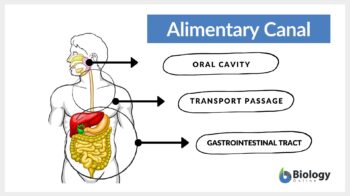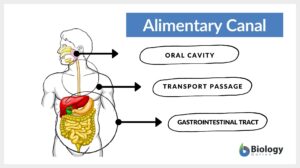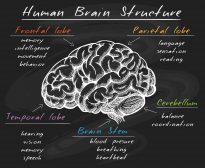
Alimentary canal
n.,
[ˈa.lɪ.mən.təɹ.i kəˈnæl]
A tubular structure of muscle and mucous membrane lining that begins at the mouth and ends at the anus
Table of Contents
Definition of Alimentary canal
What is the alimentary canal? The alimentary canal is a muscular hollow continuous tubular organ that starts at the mouth and terminates at the anus and is responsible for the digestion and absorption of the ingested food and liquids. The alimentary canal or alimentary tract is part of the digestive (gastrointestinal) system.
Primary Function of the Alimentary Canal
The primary function of the alimentary tract or alimentary canal is to ingest food material and divide it into small fractions. What happens in the alimentary canal? A series of secretions, mainly enzymes act upon these smaller fractions and convert them into smaller molecules. These small molecules are thereby absorbed into the blood and lymph circulation. These small molecules are chiefly, amino acids, small peptides, sugars, and fatty acids, which are the building blocks in the synthesis of essential proteins, carbohydrates, and lipids.
Additional functions of the alimentary canal or gastrointestinal tract
The primary function of the alimentary canal is to carry out the process of digestion of food and absorption of nutrients from it. Apart from these primary functions, there are other supplemental yet essential roles of the alimentary canal. They are as follows:
- The alimentary canal acts as an immune barrier to various harmful microbes. This function is carried out by gut-associated lymphoid tissue (GALT) and variable pH conditions that are present throughout the alimentary canal.
- The colonic bacteria also help in maintaining immune homeostasis.
- The colonic bacterial colony also prevents the growth of harmful bacteria in our alimentary canal.
- Drug metabolism also occurs in the alimentary canal wherein the drug molecule is metabolized into smaller fractions and eventually eliminated from the body. Metabolism of antigens also occurs in the alimentary canal thereby detoxifying the body of the antigens.
Anatomy of the Alimentary Canal (or gastrointestinal tract)
The anatomy of the alimentary canal differs extensively in different organisms; however, it is only seen in the organism with bilateral symmetry. In humans, the alimentary canal is highly complex and is divided into different organs and tissues that specialize in a particular function of the digestive system. In humans, the length of the alimentary canal is around 9m ~ 30 feet and is open at both ends, at one end is the mouth and at the other is the anus. Essentially, in humans, the alimentary canal is made up of the mouth, pharynx, esophagus, stomach, small intestine, and large intestine (Figure 1).
The mouth, pharynx, esophagus, stomach, and duodenum comprise the upper gastrointestinal tract whereas the small intestine and large intestine are parts of the lower gastrointestinal tract. For the different GI tract organs, refer to the GI tract diagram (Figure 1).
In general, the digestion pathway of the food in the alimentary canal is as follows-
The food is ingested in the oral cavity where it is chewed upon (this process is known as mastication of food) and is moistened with saliva. Further, the food bolus from the oral cavity is transferred to the stomach via the esophagus. In the stomach, food bolus is converted to chyme with the action of enzymatic secretions. This chyme is then transferred to the small intestine where it is further treated upon by various enzymes and the majority of the nutrients are absorbed in this part of the alimentary canal. From the small intestine, the residual food is transferred to the large intestine for the reabsorption of water and electrolytes. Once water, residual nutrients, and electrolytes are reabsorbed the solid waste is expelled from the body via the anal canal.

Parts of the Human Alimentary Canal
The alimentary system can be basically divided into three broad functional segments: (1) oral cavity, (2) transport passage, and (3) the digestive tract.
Oral cavity
The oral cavity is the part of the alimentary canal wherein food is ingested. The tongue, teeth, and palate form the components of the oral cavity. Further, the food is broken down, by the action of the teeth, into smaller fragments. The food is softened by the saliva in the oral cavity. The saliva is secreted by the salivary gland and contains enzymes like amylase and lysozyme. The movement of the jaws and tongue facilitates the movement of the food throughout the oral cavity. Once the food bolus is moistened and fragmented, it is then transferred by deglutition (swallowing) to the esophagus.
Transport passage
The transport passages simply facilitate the movement of the food bolus via peristalsis, from one part of the alimentary canal to the other without inducing any metabolic changes in it. Essentially, these transport passages are muscular tubes lined internally by stratified squamous epithelium and some mucous glands which provide lubricating mucus.
The three major transport passages of the alimentary canal include:
- Pharynx: It is located at the back of the mouth and its function is to transfer the partially digested food bolus from the oral cavity to the upper part of the esophagus. This opening is known as Oropharynx. Pharynx also serves as a bridge that connects the air chambers of the nasal cavity and upper part of the trachea. This nasal opening of the pharynx is known as nasopharynx. Nasopharynx also posses a collection of lymphatic tissue known as tonsil. Epiglottis is the cartilage that prevents the entry of food particles into the air passage.
- Esophagus: The esophagus is the transport passage between the pharynx and the stomach. The esophagus transports food bolus from the pharynx to the stomach. It is almost 25 cm long.
- Anal canal: The anal canal is the last part of the alimentary canal that serves to eliminate the residue of the ingested food, post-digestion, and absorption of the water from it, as fecal matter via the rectum to the exterior by a process known as defecation.
Digestive tract
A. Stomach
The stomach forms the first part of the digestive tract. Food bolus from the esophagus enters the stomach. The stomach is the dilated portion of the digestive tract where fragmented food that has been received from the oral cavity via the esophagus, is retained, macerated, and partially digested. The pyloric sphincter present at the lower end of the stomach prevents the passage of food until it is converted into a thick semiliquid paste or pulp (better known as chyme). The pH of the stomach is generally acidic, although the presence or absence and nature of the food determines the pH of the stomach (Table 1).
Table 1: pH in different parts of the alimentary canal
| Parts of the alimentary canal | pH |
|---|---|
| Oral cavity | 6.5-7.5 |
| Stomach | 1–2 |
| Small intestine | |
| Duodenum | 6-6.5 |
| Ileum | 7.4-7.5 |
| Large intestine | |
| Cecum | 5.7 |
| Ascending colon | 5.7 |
| Transverse colon | 6.6 |
| Descending colon | 7.0 |
The stomach is divided into five basic parts:
- Cardia: The foremost part of the stomach which is nearest to the esophagus
- Fundus: cardia is followed by the fundus part of the stomach and forms the upper part of the stomach
- Body (corpus): The body is the main part of the stomach, present between the upper and lower part of the stomach
- Antrum: The distal or the lower part of the stomach, which is near to the intestine. In this part of the stomach, mixing the food with gastric juices occurs.
- Pylorus: The last part of the stomach that acts as a regulator to control the emptying of the stomach contents into the small intestine

The stomach muscles are seldom inactive. The amount of food in the stomach determines the movement of the stomach muscles viz., expansion, or contraction. As soon as the food enters the stomach, the stomach muscle relaxes momentarily, thereafter the stomach muscle starts contracting.
Periodic stomach contractions result in churning and kneading of the food into a semisolid mixture called chyme. The rhythmic and periodic peristaltic movement of the stomach results in the movement of the food toward the pylorus and small intestine.
These cyclic and rhythmic movements of the stomach muscles are known as Gastric MMC (Migrating motor complex). Various secretions of the stomach are also released during this cycle and help in converting food bolus into chyme. These secretions include:
- Dilute acidic solution of hydrochloric acid (approximately 0.16 N)
- Proteolytic enzymes mainly, pepsin and minor quantities of other enzymes like rennin and gastric lipase
- Mucins
B. Small intestine
The small intestine is the longest part of the alimentary canal and the most important part of the alimentary canal wherein the majority of the digestive function is performed. The primary function of the small intestine is the digestion of the food followed by the absorption of the nutrients from the food.
The small intestine in adults measures approximately 6 m ~ 20-25 ft in length and have a surface area of approximately 250 m2. To increase the surface area, the small intestine exhibits significant architectural modifications in its mucosa and submucosa, i.e., folding in the mucosa and submucosa to form multiple finger-like projections or folds in the epithelium which are known as villi.
The large surface area ensures that the majority of the nutrients are absorbed during the passage of food through it. The small intestine is the main site for the absorption of amino acids, sugars, fats, and some larger molecules produced by digestion. The chyme from the stomach is transferred to the small intestine via sphincter pylorus.
The small intestine is basically divided into three main parts. They are (1) duodenum, (2) jejunum, and (3) ileum. For the small intestine’s diagram, see Figure 3.

The duodenum is the proximal 20–25 cm of the small intestine and is like a C-shape structure. The bile duct, liver, and pancreas open in the duodenum. Secretion from these glands neutralizes the acidic content of the chyme from the stomach and further promotes digestion of proteins, fats, and carbohydrates.
The duodenum is characteristically retroperitoneal and the end which emerges from the peritoneum marks the beginning of the jejunum. The jejunum, which is almost 2/5th of the whole small intestine, extends till the ileum which terminates at the ileocaecal valve.
The small intestine also has a characteristic large collection of lymphoid tissue that is known as Peyer patches. The jejunum is the main absorptive site of the digestive tract and has a complex villous system.
The ileum is characterized by the presence of GALT (i.e. the gut-associated lymphoid tissue). The lymphoid cells further combine to form large nodules i.e. Peyer’s patches. The ileum is present in the lowermost part of the abdomen and has a limited blood supply.
Peristaltic movement in the small intestine forces the food material to move through different segments of the small intestine and eventually moves to the large intestine.
The ileum is involved in the absorption of vitamin B12, bile salts, and all the unabsorbed digestion products from the duodenum and jejunum.
Water and electrolytes are absorbed throughout the small intestine. The pH of the intestine is alkaline (Table 1).
C. Large Intestine
The large intestine or large bowel or colon is the last part of the human alimentary canal. The primary function of the large intestine is to absorb water from the indigestible residue of food before it is eliminated from the body as feces.
The large intestine is the place in the alimentary canal wherein the liquid content received from the small intestine is converted into solid indigestible waste material, feces.
The large intestine specializes in the absorption of water, salts, ionic contents from the residual food. Extensive mucus production occurs in the large intestine. This is to facilitate the bowel movement to eliminate the feces from the body.
As compared to the small intestine, the large intestine is wider and shorter. It is approximately 1.5 meters, or 5 feet, in length and has smooth inner walls.
As for the pH, the level varies depending on the part of the human intestines. The overall pH of the large intestine is alkaline (in the range of 6.5 to 7.5) (Table 1).
Good bacteria or probiotic bacteria reside in the colon (more than 700 species of bacterial flora exist in the colon). These probiotic bacteria are essential for a healthy human body. These bacteria are also involved in the synthesis of Vitamins such as vitamin K. Vitamin K is essential for the normal clotting of the blood. The large intestine is further divided into the following parts: (1) caecum, (2) ascending, transverse and descending colons, (3) sigmoid colon, and (4) rectum.

Partly digested food enters into caecum from the small intestine and further moves through to enter the colon, wherein the residual water, nutrients, and electrolytes are reabsorbed. The residual solid waste further moves through the colon and is stored in the rectum for some time, and is eventually expelled from the body through the anal canal and anus. A small appendage or blind-ending tubular diverticulum that arises from the caecum is known as an appendix. The appendix is almost 5-10cm in length and has a diameter of approximately 0.8cm. Interestingly, the diameter of the appendix reduces with the increase in the age of human beings. The appendix, which is part of the alimentary canal (as opposed to the appendix of the testis, vermiform appendix, etc.), is a vestigial organ. Its specific function in the human body is yet to be established.
Layers of the Alimentary Canal
The basic structure of the walls of the alimentary tract is fundamentally the same throughout the tract. However, certain parts of the alimentary canal may vary anatomically to attain the required functionality. The walls of the human alimentary tract have four basic layers: (1) mucosa, (2) submucosa, (3) muscular layer, and (4) serosa.
Mucosa
The innermost wall that lines the lumen of the alimentary canal is the mucosa, or mucous membrane layer. The mucosa membrane is further divided into three layers-
- Epithelium
- Lamina propria- a loose connective tissue layer
- Muscularis mucosa- a smooth muscle layer
Depending upon the functionality and the role, different parts of the alimentary canal exhibit variations in the basic structure. To protect the alimentary canal from abrasion, the mucosal membrane in the mouth and the anus is made up of the stratified squamous tissue while the stomach and intestine have thin columnar cells in the epithelium in order to have absorption of the nutrients. The small intestine, the epithelium is folded into finger-like projections in order to provide a large surface area for the absorption of the nutrients. Specialized cells like goblet cells, in the mucosal membrane, secrete mucus, certain digestive enzymes.
Submucosa
An irregular and thick connective tissue layer that contains blood vessels, nerve endings, and lymphatic vessels, surrounds the mucosal membrane. The submucosal layer is made up of fibroblasts, collagen, and an acellular matrix. Certain glands like, Brunner glands, are also present in this layer.
Muscular layer or Muscularis propria
This is a smooth muscle layer that is responsible for the segmental contractions and peristaltic movement that propels the food throughout the alimentary canal. These smooth muscles are arranged in two layers namely, the outer longitudinal layer and the inner circular layer.
A thin connective tissue layer is sandwiched between the two smooth muscle layers. This connective tissue is vascular and contains myenteric nerve plexus – plexus myentericus auerbachi. The myenteric nerve plexus is responsible for the motility in the alimentary tract.
Serosa
The serosa is the loose connective tissue layer that covers organs present in the peritoneum cavity below the diaphragm. This layer contains secretory epithelial cells and is responsible for reducing friction resulting from muscle movement.
Common Disorders of the Alimentary Canal
- Vomiting: Forceful egestion of the food from the stomach. It can voluntary or involuntary action.
- Diarrhea: Overactivation or stimulation of the colon results in frequent and watery stools. Generally, this is induced by any harmful microbe ingested through food or poison.
- Constipation: Fewer and dry bowel movements or hard stool that is difficult to pass out.
- Bloody stool: Stools accompanied by the presence of blood.
- Heartburn or acidity: Acidic content refluxed into the esophagus.
- Stomach ulcers: Sore in the stomach lining. They are also known as peptic ulcers.
- Gastritis: Inflammation of the stomach lining
- Inflammatory bowel diseases (IBD): Chronic inflammation of the digestive tract particularly the large intestine. Crohn’s disease and ulcerative colitis are the two most common IBDs.
- Hemorrhoids: Swollen and painful blood vessels of the anal canal.
Evolution of the Alimentary Canal in Animals
Throughout the animal kingdom, food is an essential source of energy to carry out vital processes of life. As life evolved from the single-cell organism to complex creatures, so does the essential life processes. To extract the essential elements from food two processes are involved, ingestion of food and digestion of food. Digestion of food also can be carried out externally or internally. Organisms like spiders carry out external digestion by releasing digestive enzymes and toxins externally. However, animals that have gastrointestinal tract carry out internal digestion which is a more efficient way of digesting of food.
Single-cell organisms, such as Porifera, can directly take up the via phagocytosis or by endocytosis while in complex creatures specialized organs and tissues developed to carry out the process of digestion.
Invertebrates, for example, Platyhelminthes (flatworms), Ctenophora (comb jellies), and Cnidaria (coral, jellyfish, and sea anemones) have a single opening that serves both the functions of ingestion of food as well as the elimination of food.
In other invertebrates, like an earthworm, the simplest form of the alimentary canal is present wherein the alimentary canal has a mouth for the ingestion of food and anus for the expulsion of the food.
In primitive creatures like amphioxus, lampreys, hagfishes, etc, the alimentary canal has three components: oral cavity, pharynx, and a tubular post-pharyngeal gut without compartmentalization.
In higher vertebrates, the post-pharyngeal gut is divided into different compartments: esophagus, stomach, small intestine, large intestine, rectum, or cloaca. Cloaca is also found in marsupials and egg-laying mammals. Interestingly, the cloaca is also seen for a very short duration during the embryonic development stage of mammals.
Further depending upon the feeding habits and the nature of food consumed, the alimentary canal further evolved viz., multi-gastric, or mono-gastric alimentary canal. Herbivore animals like ruminants have a multiple compartment stomach to aid in the digestion of a cellulose-based diet while humans have a monogastric alimentary canal.
Specialized Alimentary Canals in Different Animals
There are a lot of anatomical variations in the alimentary canal amongst various animals. Certain animals are mono-gastric (single chamber stomach) while others are multi-gastric (multiple chamber stomach).
Humans and rabbits
Humans and rabbits have a mono-gastric alimentary canal. However, rabbits have enlarged small intestine and cecum, to provide a large surface area for the absorption of nutrients from the plant material.

Birds
Birds have dual-chamber stomach, the proventriculus, and the gizzard. In proventriculus, food is digested with the help of gastric juices while in the gizzard food is soaked, mechanically grounded, and eventually stored. Birds also regurgitate undigested food. Birds do not have teeth in their oral cavity and do not carry out mastication of food. The beaks of the birds are adapted to grind the food and hence different species of birds have different shapes of beaks. The absorption of nutrients occurs in the small intestine and the waste is eliminated from the opening called the cloaca.

Ruminants
Ruminants like sheep, bovine, goats, etc., possess a multi-gastric alimentary canal. This adaptation is to digest the cellulose, which is the major component of the plant-based ruminant diet. The stomach is divided into four chambers:
- Rumen
- Reticulum
- Omasum
- Abomasum
The abomasum is considered to be equivalent to the mono-gastric stomach or true stomach due to the presence of gastric secretions.
In the rumen and reticulum, the stomach is rich in microbial flora that aids in the breakdown of cellulose in the food. In these chambers, fermentation of the ingested food also occurs, resulting in the generation of a high volume of gases. These gases are periodically expelled out by the animal. The ruminants regurgitate the food material or the cud from the reticulum chamber and chew it again and this cud is then transferred to the third chamber, the omasum.
In omasum removal of water occurs. From the omasum, the food material is then transferred to the abomasum for digestion by the enzymes and gastric secretions and is eventually transferred to the small intestine. The absorption of nutrients occurs in the small intestine while the elimination of the waste occurs via the large intestine.

Pseudo-ruminants
In contrast to the ruminants, pseudo-ruminants like camel have a three-chamber stomach. The rumen is absent in camels. Omasum, abomasum, and reticulum are the three compartments of the stomach of the camel. Interestingly, camels have an enlarged cecum. Cecum in camel is rich in microbial flora and is responsible for the digestion of the plant-based roughage, which forms the major part of the diet of camels.
Insects
The alimentary canal in insects like cockroaches starts at the mouth and ends at the anus and is subdivided into three parts-
- Anterior stomodaeum (foregut): This consist of the pharynx, esophagus, crop, and gizzard
- Middle midgut (mesenteron or stomach or ventriculus)
- Posterior hindgut (proctodaeum): This consist of the ileum (or small intestine), colon (or large intestine), and rectum

Fish
Fishes do not possess a large intestine; however, they have a short rectum. The alimentary canal of fishes has an oral cavity to ingest food followed by an esophagus to transfer the food to the stomach for digestion. The nutrients are absorbed in the intestine and eliminate the waste from the vent (equivalent to anus). The intestine is classified as the proximal intestine and distal intestine in fishes.

Try to answer the quiz below to check what you have learned so far about alimentary canal.
References
· Roman A.K.S., Kim T., Shivdasani R.A. The Alimentary Canal. (2016). In: Kaufman’s Atlas of Mouse Development Supplement, Baldock R., Bard J., Davidson D. R., Morriss-Kay G. (Eds) Academic Press, pp 77-84, doi.org/10.1016/B978-0-12-800043-4.00005-1.
· Day R.M. Alimentary Tract. (2019). In: Principles of Regenerative Medicine. Atala A., Lanza R., Mikos A. G., Nerem R. (Eds) Academic Press, 2019, 3rd ed., pp. 1131-1148, doi.org/10.1016/B978-0-12-809880-6.00064-3.
· Boland M. (2016). Human digestion–a processing perspective. Journal of the science of food and agriculture, 96(7), 2275–2283. https://doi.org/10.1002/jsfa.7601.
· Fallingborg J. (1999). Intraluminal pH of the human gastrointestinal tract. Danish medical bulletin, 46(3), 183–196.
· Ogobuiro I, Gonzales J, Tuma F. Physiology, Gastrointestinal. [2020]. In: StatPearls [Internet]. Treasure Island (FL): StatPearls Publishing; 2020 Jan-. Available from: https://www.ncbi.nlm.nih.gov/books/NBK537103/
· Greenwood-Van Meerveld, B., Johnson, A. C., & Grundy, D. (2017). Gastrointestinal Physiology and Function. Handbook of experimental pharmacology, 239, 1–16. https://doi.org/10.1007/164_2016_118.
· Grassi, M., Petraccia, L., Mennuni, G., Fontana, M., Scarno, A., Sabetta, S., & Fraioli, A. (2011). Changes, functional disorders, and diseases in the gastrointestinal tract of elderly. Nutricion hospitalaria, 26(4), 659–668. https://doi.org/10.1590/S0212-16112011000400001.
· Hartenstein, V., Martinez, P. Structure, development and evolution of the digestive system. Cell Tissue Res 377, 289–292 (2019). https://doi.org/10.1007/s00441-019-03102-x
©BiologyOnline.com. Content provided and moderated by BiologyOnline Editors.








